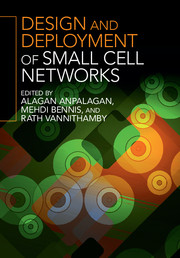Book contents
- Frontmatter
- Contents
- List of contributors
- Preface
- 1 Mobility performance optimization for 3GPP LTE HetNets
- 2 Design and performance analysis of multi-radio small cell networks
- 3 Dynamic TDD small cell management
- 4 3GPP RAN standards for small cells
- 5 Dense networks of small cells
- 6 Traffic offloading scenarios for heterogeneous networks
- 7 Required number of small cell access points in heterogeneous wireless networks
- 8 Small cell deployments: system scenarios, performance, and analysis
- 9 Temporary cognitive small cell networks for rapid and emergency deployments
- 10 Long-term evolution (LTE) and LTE-Advanced activities in small cell networks
- 11 Game theory and learning techniques for self-organization in small cell networks
- 12 Energy efficient strategies with BS sleep mode in green small cell networks
- 13 Mobility management in small cell heterogeneous networks
- 14 The art of deploying small cells: field trial experiments, system design, performance prediction, and deployment feasibility
- 15 Centralized self-optimization of interference management in LTE-A HetNets
- 16 Self-organized ICIC for SCN
- 17 Large-scale deployment and scalability
- 18 Energy efficient heterogeneous networks
- 19 Time- and frequency-domain e-ICIC with single- and multi-flow carrier aggregation in HetNets
- Index
- References
2 - Design and performance analysis of multi-radio small cell networks
Published online by Cambridge University Press: 05 December 2015
- Frontmatter
- Contents
- List of contributors
- Preface
- 1 Mobility performance optimization for 3GPP LTE HetNets
- 2 Design and performance analysis of multi-radio small cell networks
- 3 Dynamic TDD small cell management
- 4 3GPP RAN standards for small cells
- 5 Dense networks of small cells
- 6 Traffic offloading scenarios for heterogeneous networks
- 7 Required number of small cell access points in heterogeneous wireless networks
- 8 Small cell deployments: system scenarios, performance, and analysis
- 9 Temporary cognitive small cell networks for rapid and emergency deployments
- 10 Long-term evolution (LTE) and LTE-Advanced activities in small cell networks
- 11 Game theory and learning techniques for self-organization in small cell networks
- 12 Energy efficient strategies with BS sleep mode in green small cell networks
- 13 Mobility management in small cell heterogeneous networks
- 14 The art of deploying small cells: field trial experiments, system design, performance prediction, and deployment feasibility
- 15 Centralized self-optimization of interference management in LTE-A HetNets
- 16 Self-organized ICIC for SCN
- 17 Large-scale deployment and scalability
- 18 Energy efficient heterogeneous networks
- 19 Time- and frequency-domain e-ICIC with single- and multi-flow carrier aggregation in HetNets
- Index
- References
Summary
Multi-tier, heterogeneous networks (HetNets) using small cells (e.g., pico and femto cells) are an important part of operators’ strategy to add low-cost network capacity through aggressive reuse of the cellular spectrum. In the near term, a number of operators have also relied on un-licensed WiFi networks as a readily available means to offload traffic demand. However, the use of WiFi is expected to remain an integral part of operators’ long-term strategy to address future capacity needs, as licensed spectrum continues to be scarce and expensive. Efficient integration of cellular HetNets with alternate radio access technologies (RATs), such as WiFi, is therefore essential for next-generation networks.
This chapter describes several WiFi-based multi-RAT HetNet deployments and architectures, and evaluates the associated performance benefits. In particular, we consider deployments featuring integrated multi-RAT small cells with co-located WiFi and LTE interfaces, where tighter coordination across the two radio links becomes feasible. Integrated multi-RAT small cells are an emerging industry trend toward leveraging common infrastructure and lowering deployment costs when the footprints of WiFi and cellular networks overlap. Several techniques for cross-RAT coordination and radio resource management are reviewed and system performance results showing significant capacity and quality service gains are presented.
Introduction
Multi-tier HetNets based on small cells (e.g. pico cells, femto cells, relay cells, WiFi APs, etc.) are considered to be a fundamental technology for cellular operators to address capacity and coverage demands of future 5G networks. Typical HetNet deployment architectures comprise an overlay of a macro cell network with additional tiers of densely deployed cells with smaller footprints, such as picos, femtos, relay nodes, WiFi access points, etc. Figure 2.1 illustrates the various deployment options in a multi-radio HetNet.
HetNets allow for greater flexibility in adapting the network infrastructure according to the capacity, coverage, and cost needs of a given deployment. As shown, the macro base station tier may be used for providing wide area coverage and seamless mobility, across large geographic areas, while smaller inexpensive low-powered small cells may be deployed, as needed, to improve coverage by moving infrastructure closer to the clients (such as for indoor deployments), as well as to add capacity in areas with higher traffic demand. Conceptually, mobile clients with direct client-to-client communication may also be considered as one of the tiers within this hierarchical deployment, wherein the clients can cooperate with other clients to locally improve access in an inexpensive manner.
- Type
- Chapter
- Information
- Design and Deployment of Small Cell Networks , pp. 31 - 57Publisher: Cambridge University PressPrint publication year: 2015



